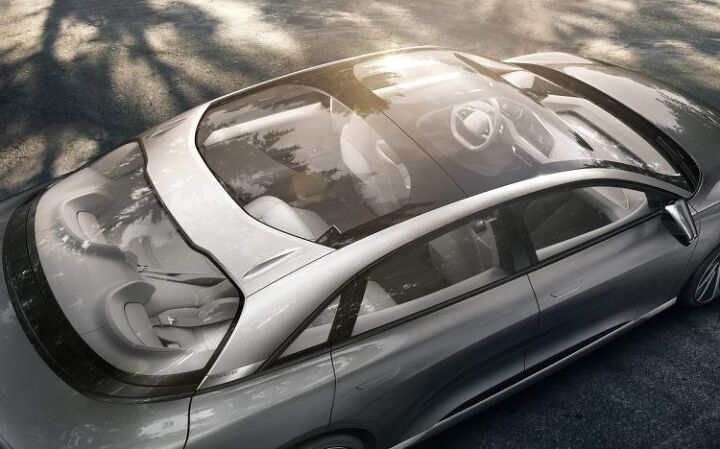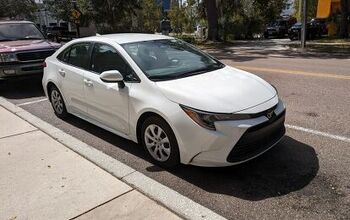Lucid Motors is Working on an Anti-Noise Signal for Its Electric Car

One of the first things you notice in the silence of an electric car is how prevalent wind and tire noise can be without an internal combustion engine to breakup the aural monotony. While no one has ever slipped into madness due to an overabundance of road noise, rubber grinding against concrete at seventy-five miles an hour isn’t the most pleasant sound in the world, either.
Lucid Motors promised that its upcoming Air EV would possess an audio system equipped with active noise cancellation to ensure that its interior remains a silent space. However, we are only just now discovering how seriously they took that promise.
The vehicle’s 29-speaker audio system can devote up to eleven speakers to noise cancellation using “anti-noise,” while the car itself takes advantage of acoustic laminated glass and other sound dampening materials. Lucid claims it has modeled the software for varying road surfaces, realizing that roads in North America typically use coarser variations of asphalt than those smooth Europeans.
According to the company, the anti-noise signal piped in through those eleven speakers can create quiet zones for the vehicle’s occupants and is endlessly adaptive. Lucid says the system requires an previously unheard of number of sensors, several digital signal processors, software developed specifically for broadband noise, and careful integration into the vehicle’s audio system to function properly.
That’s a lot of effort for something that, when working, is completely imperceptible to the human ear.
However, Lucid says it is those little indiscernible features that separate a quality product from a lesser one. Devoting an entire engineering team to “ Noise and Vibration Harmony” is, apparently, par for the course when you’re trying to raise the bar.
While it would be easy — and predictable — for a skeptic like myself to attribute this entire thing to one big fat marketing gimmick, active-noise-cancellation technology has advanced in leaps and bounds in the 21st century. Texas Instruments even has a particularly comprehensive report on the subjec t that I wasted an hour of my life reading through.
While steady droning sounds are easy to eliminate, sounds that are variable and unstructured (like road noise) are much more difficult to counter. Thus the need for the Air’s sensor array, specialized software, and multiple processors devoted specifically to developing ambient sounds to counter noise created by air or pavement.
In addition to the computerized adaptive anti-noise, Lucid has done loads of digital modeling to tweak the car’s aerodynamics and suspension to reduce sound — even altering the vehicle’s shape to encourage less of an unpleasant din. The company says that feature, in addition to large-scale usage of sound-dampening material and interior acoustics, should make the Air’s cabin one of the quietest in existence.
[Images: Lucid Motors]

A staunch consumer advocate tracking industry trends and regulation. Before joining TTAC, Matt spent a decade working for marketing and research firms based in NYC. Clients included several of the world’s largest automakers, global tire brands, and aftermarket part suppliers. Dissatisfied with the corporate world and resentful of having to wear suits everyday, he pivoted to writing about cars. Since then, that man has become an ardent supporter of the right-to-repair movement, been interviewed on the auto industry by national radio broadcasts, driven more rental cars than anyone ever should, participated in amateur rallying events, and received the requisite minimum training as sanctioned by the SCCA. Handy with a wrench, Matt grew up surrounded by Detroit auto workers and managed to get a pizza delivery job before he was legally eligible. He later found himself driving box trucks through Manhattan, guaranteeing future sympathy for actual truckers. He continues to conduct research pertaining to the automotive sector as an independent contractor and has since moved back to his native Michigan, closer to where the cars are born. A contrarian, Matt claims to prefer understeer — stating that front and all-wheel drive vehicles cater best to his driving style.
More by Matt Posky
Latest Car Reviews
Read moreLatest Product Reviews
Read moreRecent Comments
- ToolGuy TG likes price reductions.
- ToolGuy I could go for a Mustang with a Subaru powertrain. (Maybe some additional ground clearance.)
- ToolGuy Does Tim Healey care about TTAC? 😉
- ToolGuy I am slashing my food budget by 1%.
- ToolGuy TG grows skeptical about his government protecting him from bad decisions.



































Comments
Join the conversation
I am heartened to see that a fantasy vehicle that will never be produced can run so silently.
With the way things in the digital audio world I am somewhat surprised that this has taken so long to appear. In Pro Tools - and other DAWs - one can take an two tracks of audio (same instrument from 2 different mics), throw one 180 degrees out of phase and the only thing left is the differences between the two. Same thing for this application; 11 mics measuring interior noise at the specific locations of the speakers used for the noise cancellation; use real time digital processors to invert the polarity of the sampled noise and Wah-Lah - reduced interior noise in those 11 specific areas as it is cancelled out.